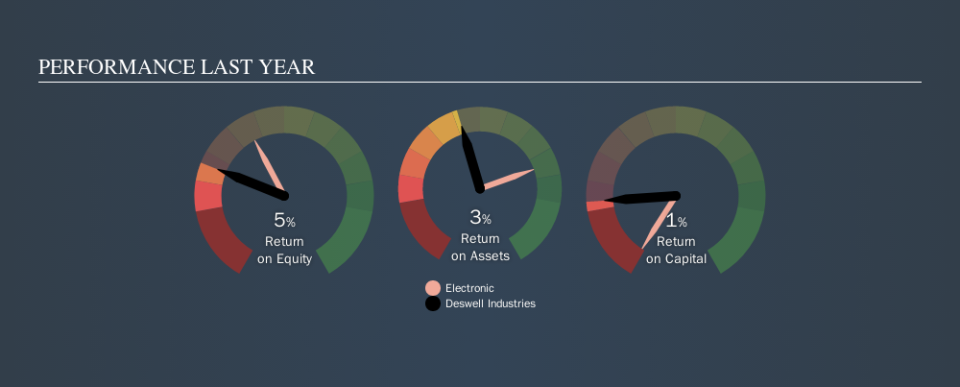Examining Deswell Industries, Inc.’s (NASDAQ:DSWL) Weak Return On Capital Employed

Today we are going to look at Deswell Industries, Inc. (NASDAQ:DSWL) to see whether it might be an attractive investment prospect. In particular, we'll consider its Return On Capital Employed (ROCE), as that can give us insight into how profitably the company is able to employ capital in its business.
Firstly, we'll go over how we calculate ROCE. Then we'll compare its ROCE to similar companies. Last but not least, we'll look at what impact its current liabilities have on its ROCE.
What is Return On Capital Employed (ROCE)?
ROCE is a measure of a company's yearly pre-tax profit (its return), relative to the capital employed in the business. All else being equal, a better business will have a higher ROCE. Overall, it is a valuable metric that has its flaws. Renowned investment researcher Michael Mauboussin has suggested that a high ROCE can indicate that 'one dollar invested in the company generates value of more than one dollar'.
How Do You Calculate Return On Capital Employed?
Analysts use this formula to calculate return on capital employed:
Return on Capital Employed = Earnings Before Interest and Tax (EBIT) ÷ (Total Assets - Current Liabilities)
Or for Deswell Industries:
0.0075 = US$637k ÷ (US$100m - US$16m) (Based on the trailing twelve months to March 2019.)
So, Deswell Industries has an ROCE of 0.8%.
See our latest analysis for Deswell Industries
Does Deswell Industries Have A Good ROCE?
ROCE is commonly used for comparing the performance of similar businesses. We can see Deswell Industries's ROCE is meaningfully below the Electronic industry average of 12%. This performance is not ideal, as it suggests the company may not be deploying its capital as effectively as some competitors. Regardless of how Deswell Industries stacks up against its industry, its ROCE in absolute terms is quite low (especially compared to a bank account). Readers may wish to look for more rewarding investments.
Deswell Industries has an ROCE of 0.8%, but it didn't have an ROCE 3 years ago, since it was unprofitable. That suggests the business has returned to profitability. You can click on the image below to see (in greater detail) how Deswell Industries's past growth compares to other companies.
When considering ROCE, bear in mind that it reflects the past and does not necessarily predict the future. ROCE can be misleading for companies in cyclical industries, with returns looking impressive during the boom times, but very weak during the busts. This is because ROCE only looks at one year, instead of considering returns across a whole cycle. How cyclical is Deswell Industries? You can see for yourself by looking at this free graph of past earnings, revenue and cash flow.
Do Deswell Industries's Current Liabilities Skew Its ROCE?
Current liabilities are short term bills and invoices that need to be paid in 12 months or less. Due to the way the ROCE equation works, having large bills due in the near term can make it look as though a company has less capital employed, and thus a higher ROCE than usual. To counteract this, we check if a company has high current liabilities, relative to its total assets.
Deswell Industries has total liabilities of US$16m and total assets of US$100m. As a result, its current liabilities are equal to approximately 16% of its total assets. With a very reasonable level of current liabilities, so the impact on ROCE is fairly minimal.
What We Can Learn From Deswell Industries's ROCE
That's not a bad thing, however Deswell Industries has a weak ROCE and may not be an attractive investment. But note: make sure you look for a great company, not just the first idea you come across. So take a peek at this free list of interesting companies with strong recent earnings growth (and a P/E ratio below 20).
If you are like me, then you will not want to miss this free list of growing companies that insiders are buying.
We aim to bring you long-term focused research analysis driven by fundamental data. Note that our analysis may not factor in the latest price-sensitive company announcements or qualitative material.
If you spot an error that warrants correction, please contact the editor at editorial-team@simplywallst.com. This article by Simply Wall St is general in nature. It does not constitute a recommendation to buy or sell any stock, and does not take account of your objectives, or your financial situation. Simply Wall St has no position in the stocks mentioned. Thank you for reading.

 Yahoo Movies
Yahoo Movies 

